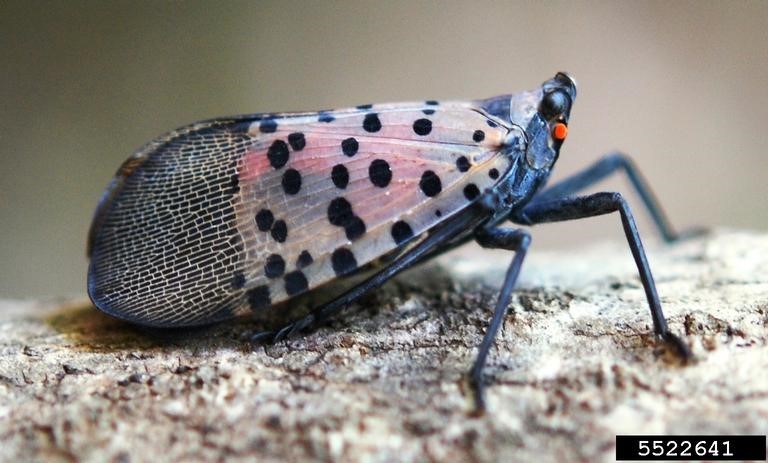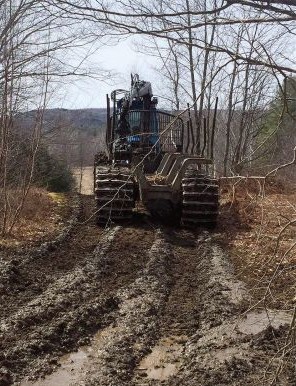Project Canopy
No Live Spotted Lanternflies Found
 AUGUSTA - The Maine Department of Agricultural, Conservation and Forestry (DACF) today announced finding egg masses of the invasive spotted lanternfly (SLF) on trees in Maine communities and is urging residents to report any sign of the invasive pest. The egg masses were found on trees from Pennsylvania, where SLF is established and planted in Boothbay, Freeport, Northeast Harbor, and Yarmouth.
DACF urges anyone who received goods or materials, such as plants, landscaping materials, or outdoor furniture, from a state with a known SLF infestation to carefully check the materials, including any packaging, for signs of SLF. There are currently known populations of SLF in Connecticut, Delaware, Maryland, New Jersey, New York, Pennsylvania, Virginia, and West Virginia.
If any life stages of SLF are found, residents should take a photo or collect the specimen and report any pest potential sightings to bugwatch@maine.gov. Residents should look for large, gray insects, about one inch long, with black spots and red underwings, or inch-long, rectangular yellowish-brown egg masses covered with a gray waxy coating. Egg masses may be found on any flat surface.
“These most recent finds call attention to the fact that there are many ways that spotted lanternfly can travel here from other states,” said State Horticulturist, Gary Fish. “Early detection plays an important role in the protection of our state’s economic and ecological resources from invasive species, and we ask anyone who may have received shipments of wood, ornamental plants, or any other materials from Pennsylvania or other Northeastern states to help protect the natural resources and agricultural industries of Maine by checking for and reporting any signs of spotted lanternfly.”
The spotted lanternfly (Lycorma delicatula) is an invasive sap-feeding insect from Asia first found in the United States in 2014, in Pennsylvania. While the preferred host plant of this pest is tree-of-heaven (Ailanthus altissima), spotted lanternfly attacks over 100 species of trees, shrubs, and vines, and has the potential to impact a broad range of agricultural commodities, including apples, peaches, grapes/wine, maple syrup, as well as the ornamental nursery industry.
As many families across the state spend more time at home during the COVID-19 pandemic and are undertaking activities such as gardening to improve their outdoor spaces, Maine has seen an increase in purchases of items such as outdoor furniture, play structures, gazebos, as well as trees and shrubs for landscaping. When shipped from areas with SLF infestations, these products, and the vehicles used for transportation, can unintentionally carry the pest into new areas.
Because no live SLF has been found in Maine, there is currently no evidence that SLF has become established. The DACF Horticulture Program has inspected all the suspect trees and asks the homeowners and landscape companies to keep an eye on the areas where egg masses were found to confirm that no live populations are present. Spotted lanternfly has not previously been found in Maine.
For more information about the spotted lanternfly, please visit: https://www.maine.gov/dacf/php/caps/slf/index.shtml
If you have seen any of the life stages of this insect in Maine, please report it: bugwatch@maine.gov.
 Today, the Department of Agriculture, Conservation and Forestry's (DACF) Maine Forest Service (MFS) released its list of the most massive known tree of each species growing in Maine. Maine's 2020 Register of Big Trees contains 146 trees, representing 138 species. The responsibility of determining Maine's eligible species rests with DACF's Project Canopy, which supports community forestry projects. MFS has compiled its Register of Big Trees since 1968.
Maine has several existing and a few new nominations to the National Register of Champion Trees, due out Wednesday, September 30. The Eastern white pine located in Morrill was a National Champion and lost its status after losing a portion of its crown in a 2018 windstorm. The new state champion Eastern white pine is located in Sumner and has been nominated to take its place. The National Champion black spruce in Brooklin, yellow birch in Wayne, and common buckthorn in Portland are defending their national ranks. New potential champions include a mountain paper birch in Bethel, eastern hophornbeam in Paris, common juniper in Norridgewock, and a striped maple in Bristol.
"State champion big trees capture our imagination for their size and strength," said Jan Santerre, Project Canopy Coordinator. "They are symbols of the work trees do for the quality of the environment and our quality of life." Big trees provide more cooling shade and habitat for wildlife to perch and nest. They sequester more carbon dioxide, trap more pollutants, and purify more water.
To determine if a tree is a champion, the Maine Forest Service gives each tree a score based on a formula that adds circumference in inches, height in feet, and ¼ of the crown spread. In addition to the new eastern white pine champion in Sumner, there are several other notable changes to the list since last publication – the massive white oak in Pittston, which was on the state registry since its inception, was brought down by age and gravity. A rival in Kennebunk replaces it. As most are aware, the New England Champion American elm known as "Herbie," located in Yarmouth, was cut down shortly after the last Register's publication. A lovely specimen in Castine replaces it. To our knowledge, the only example on the list that has maintained its status since the initial publication is a white ash located in Waterford.
For more information on Maine's Register of Big Trees, please contact Jan Santerre, Big Tree Coordinator, at the Maine Forest Service, 22 State House Station, Augusta, ME 04333 or call 1-207-287-2791. The Register can also be viewed by visiting the Maine Forest Service website: https://www.maine.gov/dacf/mfs/publications/index.html
 TOPSHAM — Topsham’s solid waste director is working to destroy an invasive species of earthworm called crazy worms that were discovered in a woodchip pile at the town’s transfer station early this summer.
The worms have the potential to damage local forests.
Crazy worms are a type of earthworm native to East Asia, according to the Maine Department of Agriculture, Conservation and Forestry’s horticulture program. The worms are native to Korea and Japan, and are now found in the United States from Maine to South Carolina and west to Wisconsin.
According to the state’s crazy worm website, the worms jump and thrash about and may shed their tail when handled. They also have a milky white, smooth band around their bodies and leave behind soil that looks like coffee grounds. Read more...
 When Carmen Storms, 69, looks down at the trees of Melnea Cass Boulevard from her eighth-floor apartment, she thinks of her father, Alvin — twice driven from his home during Boston's urban renewal boom of the 1950s and '60s, when the city used eminent domain to raze the homes and businesses of Black families.
The only time Storms saw him cry was during the family's second move, forced out in the name of a highway that never happened. The planned inner belt was stopped by the community it displaced. As a consolation prize, the city of Boston turned the land into a suburban-like boulevard, named it after a local civil rights icon — Melnea Cass — and lined it with 600 trees.
Today, those trees are a lonely green smirk across Roxbury, where past injustices still haunt and heat the historic and political core of Boston's Black community. The neighborhood, where more than 80% of residents are people of color, is one of Boston's "heat islands" — made hotter by too much asphalt and too few trees.
Boston's climate adaptation plans recognize the important cooling role of trees and aim to increase the city's urban tree canopy 10% by 2030. Nevertheless, this summer, bulldozers again threatened the community, targeting 120 of the oaks, maples and lindens as part of the "Melnea Cass" road safety and rehabilitation project many say contradicts Boston's climate adaptation plan. Read more...

NORTHERN WOODLANDS - Winter has traditionally been a productive time of year for the forest products industry in the Northeast. Landowners schedule timber harvests in the winter season to take advantage of frozen grounds so that equipment can travel with minimal damage to soils and water resources. Snow cover helps protect logging equipment from wear. For mills, winter is the time to stockpile a supply of wood in anticipation of reduced availability in the spring mud season.
In recent years, warmer and wetter conditions have interrupted these established work patterns. In much of the northeastern United States, average December and January temperatures are more than four degrees warmer than they were in the 1980s. Read more...
|
Five Community Resilience Projects Receive Maine Coastal Community Grants
New PLT Activity Collections: A Theme-Based Series for Educators
Rethinking Black Locust
Oct 7 - Webinar: Verticillium nonalfalfae as a Biological Control Agent for Tree of Heaven, 1pm.
Oct 14 - Webinar: Millions, Billions, and Trillions - Do You Have the Tools to Keep New Trees Alive? 1pm.
Oct 14 - Webinar: The Green Connector: Building Municipal Resiliency through Nature-based Approaches, 1pm
|